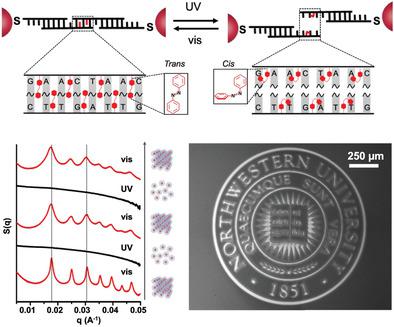当前位置:
X-MOL 学术
›
Adv. Mater.
›
论文详情
Our official English website, www.x-mol.net, welcomes your
feedback! (Note: you will need to create a separate account there.)
Light‐Responsive Colloidal Crystals Engineered with DNA
Advanced Materials ( IF 27.4 ) Pub Date : 2020-01-15 , DOI: 10.1002/adma.201906600 Jinghan Zhu 1, 2 , Haixin Lin 2, 3 , Youngeun Kim 1, 2 , Muwen Yang 2, 3 , Kacper Skakuj 2, 3 , Jingshan S Du 1, 2 , Byeongdu Lee 4 , George C Schatz 2, 3 , Richard P Van Duyne 2, 3 , Chad A Mirkin 1, 2, 3
Advanced Materials ( IF 27.4 ) Pub Date : 2020-01-15 , DOI: 10.1002/adma.201906600 Jinghan Zhu 1, 2 , Haixin Lin 2, 3 , Youngeun Kim 1, 2 , Muwen Yang 2, 3 , Kacper Skakuj 2, 3 , Jingshan S Du 1, 2 , Byeongdu Lee 4 , George C Schatz 2, 3 , Richard P Van Duyne 2, 3 , Chad A Mirkin 1, 2, 3
Affiliation

|
A novel method for synthesizing and photopatterning colloidal crystals via light‐responsive DNA is developed. These crystals are composed of 10–30 nm gold nanoparticles interconnected with azobenzene‐modified DNA strands. The photoisomerization of the azobenzene molecules leads to reversible assembly and disassembly of the base‐centered cubic (bcc) and face‐centered cubic (fcc) crystalline nanoparticle lattices. In addition, UV light is used as a trigger to selectively remove nanoparticles on centimeter‐scale thin films of colloidal crystals, allowing them to be photopatterned into preconceived shapes. The design of the azobenzene‐modified linking DNA is critical and involves complementary strands, with azobenzene moieties deliberately staggered between the bases that define the complementary code. This results in a tunable wavelength‐dependent melting temperature (Tm) window (4.5–15 °C) and one suitable for affecting the desired transformations. In addition to the isomeric state of the azobenzene groups, the size of the particles can be used to modulate the Tm window over which these structures are light‐responsive.
中文翻译:

用 DNA 设计的光响应胶体晶体
开发了一种通过光响应 DNA 合成胶体晶体并进行光图案化的新方法。这些晶体由与偶氮苯修饰的 DNA 链互连的 10-30 nm 金纳米粒子组成。偶氮苯分子的光异构化导致基心立方(bcc)和面心立方(fcc)晶体纳米颗粒晶格的可逆组装和分解。此外,紫外光被用作触发器,选择性地去除厘米级胶体晶体薄膜上的纳米颗粒,使它们能够被光刻成预先设想的形状。偶氮苯修饰的连接 DNA 的设计至关重要,涉及互补链,偶氮苯部分故意交错在定义互补代码的碱基之间。这导致了一个可调的波长相关熔化温度 ( T m ) 窗口 (4.5–15 °C),并且适合影响所需的转变。除了偶氮苯基团的异构态之外,颗粒的尺寸还可用于调节这些结构具有光响应性的T m窗口。
更新日期:2020-02-24
中文翻译:

用 DNA 设计的光响应胶体晶体
开发了一种通过光响应 DNA 合成胶体晶体并进行光图案化的新方法。这些晶体由与偶氮苯修饰的 DNA 链互连的 10-30 nm 金纳米粒子组成。偶氮苯分子的光异构化导致基心立方(bcc)和面心立方(fcc)晶体纳米颗粒晶格的可逆组装和分解。此外,紫外光被用作触发器,选择性地去除厘米级胶体晶体薄膜上的纳米颗粒,使它们能够被光刻成预先设想的形状。偶氮苯修饰的连接 DNA 的设计至关重要,涉及互补链,偶氮苯部分故意交错在定义互补代码的碱基之间。这导致了一个可调的波长相关熔化温度 ( T m ) 窗口 (4.5–15 °C),并且适合影响所需的转变。除了偶氮苯基团的异构态之外,颗粒的尺寸还可用于调节这些结构具有光响应性的T m窗口。











































 京公网安备 11010802027423号
京公网安备 11010802027423号